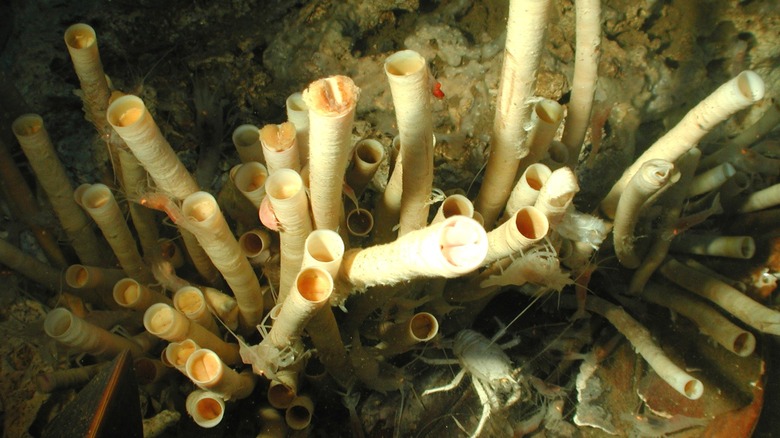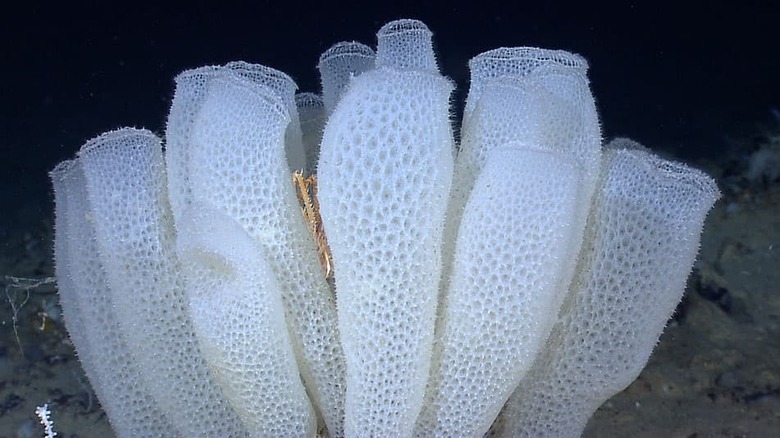How Long Tortoises Live And 5 Animals That Live Longer
As human beings, we enjoy the longest average lifespan of any terrestrial mammal, but our longevity pales in comparison to some other animals, such as tortoises. Most tortoise species are easily capable of reaching centenarian status, thanks to their slow-and-steady lifestyles. Animals with slower metabolisms and heart rates tend to outlive those with faster ones, and the average heart rate for a giant tortoise is a mere ten beats per minute. Compare that to the normal range for an adult human, which is 60-100 beats per minute, and you can easily see why tortoises don't wear down as fast. Tortoises' low metabolic rates also mean that their bodies accumulate free radicals — chemicals linked to aging and DNA damage — at a much slower rate.
As of late 2024, Guinness World Records recognizes the longest-living land animal as a Seychelles giant tortoise named Jonathan. Residing on the remote Atlantic island of St. Helena, Jonathan the giant tortoise is estimated to have been born in 1832, which makes him older than some of the greatest inventions of the industrial revolution, such as light bulbs and Morse code. It is claimed that Jonathan is the longest-lived tortoise in history, but he has a credible competitor in an Aldabra tortoise named Adwaita, who was once a pet of Robert Clive, the first British Governor of India. Adwaita ended up outliving Clive by 233 years, eventually dying at a Kolkata zoo in 2006. He was estimated to be well over 250, but while that number is impressive on land, it has nothing on the creatures of the deep.
Tubeworms (over 300 years)
Tubeworms are long invertebrates that live underwater, each anchored to a fixed position by a tube-shaped shell made of chitin, the same material found in the exoskeletons of crustaceans and insects. There are numerous species of tubeworms, but scientists are particularly fascinated by a group known as cold seep tubeworms, which display extraordinary longevity and can reach ages in the hundreds of years. Cold seep tube worms are found in the deepest parts of the Gulf of Mexico around areas called cold seeps, which are fissures in the ocean floor that release gasses, essentially like cold versions of hydrothermal vents. Tubeworms have no digestive systems, but through a symbiotic relationship with bacteria in their bodies, they are able to extract energy from the cold seeps themselves.
Scientists aren't quite sure why tube worms can live so long. It may have to do with the unique way they get their energy without a digestive system, or it may be that natural selection eliminated shorter-living members because they couldn't live long enough to procreate in their hostile environment. Amongst the cold seep tubeworms, no species displays greater longevity than Escarpia laminata. This resident of the Gulf of Mexico has been found to consistently live for a century or two, but some individuals have been estimated to be as much as 300 years old. They also have a unique aging curve, where they grow rapidly over the first decade of their lives, after which their growth slows to just 1 centimeter per year.
Greenland sharks (perhaps over 500 years)
Most of the world's oldest living things can be found deep in frigid ocean waters. Such an environment is conducive to longevity because the cold keeps metabolic rates low. A perfect example of this is the Greenland shark, which lives in the Arctic Ocean, where temperatures can drop to just 1 degree Celsius. Like tortoises, Greenland sharks are noted for their slow movements and large bodies, swimming at a mere 2 miles per hour and reaching up to 23 feet in length. That means the largest Greenland sharks can get bigger than a great white shark, though not nearly as big as the largest shark ever. Despite their massive size, they only grow about one centimeter per year, which gives you a hint of how old the largest members of the species must be.
Scientists have long suspected that the Greenland shark could be among the longest-lived species in the world, but it wasn't until the last decade that they were able to prove this. In a 2016 study published in Science, a team of researchers carbon dated numerous lenses from the eyes of Greenland sharks and determined that the largest specimen, a 16-foot-long female, was probably around 392 years old, but might be as much as 512 years old. What's even more shocking is the fact that these sharks have a gestation period of as much as 18 years, and they likely do not reach sexual maturity until they are already a century and a half old. Scientists now believe that the Greenland shark is the longest-living vertebrate on Earth.
[Featured image by Hemming1952 via Wikimedia Commons | Cropped and scaled | CC BY-SA 4.0]
Ocean quahogs (507 years)
The ocean quahog is a type of clam found in the North Atlantic Ocean. They are a particularly large species of clam, capable of reaching lengths over four inches. There's a chance you've enjoyed them as food, as ocean quahogs are a common ingredient in clam chowder. Little might you know that the key ingredient in your meal could be well over 100 years old. Not only do they have long lifespans, but they are one of the most ancient creatures still living on Earth: Ocean quahogs are the last surviving species within the family Arcticidae, which has existed since the Jurassic period over 145 million years ago.
The most famous ocean quahog was a specimen found off the coast of Iceland in 2006. Researchers at Bangor University in Wales used multiple methods of analysis, including carbon dating, to determine its age. They found that the clam in question was 507 years old, and they subsequently named it Ming, as its life dated all the way back to China's Ming Dynasty. Unfortunately, in order to determine Ming's age, the researchers opened its shell, and due to the way clamshells are made, this ended up killing Ming. It was only later that they realized how notable their specimen was. If not for this turn of events, who knows how long Ming could have lived?
Glass sponges (over 10,000 years)
Sea sponges don't look like animals at first glance. They are immobile, attaching themselves to undersea surfaces, giving them a certain plant-like look. There are over 8,000 different species of sponge, but one in particular has fascinated scientists with its astounding longevity: Glass sponges, which live deep in the ocean, feeding on plankton and bacteria filtered through their many pores, and which can live not just hundreds, but thousands of years. The species emerged some 570 million years ago, meaning glass sponges predate all land-dwelling life. The scientific community long believed glass sponges to be extinct, likely for millions of years, but in the 1980s, researchers discovered a glass sponge reef in Canada. It's now known that glass sponges are widely distributed throughout the world's oceans, particularly in the waters around Antarctica.
Since the discovery of living glass sponges, the scientific community has marveled at their longevity. We are able to estimate their age by chemical analysis of the long, tube-shaped structures they build to protect themselves, which are partially made from silica, a material used in glass-making, hence the sponge's name. Through analyzing these structures, scientists have identified some glass sponges as being over 11,000 years old. One specimen from the South China Sea has been estimated at 17,000 years old, which means it was born during the last Ice Age.
Immortal jellyfish (immortal?)
Some of the most impressive life spans in the animal kingdom can be found in the phylum Cnidaria, which includes corals that live for thousands of years. As long as that may sound, nothing compares to another kind of Cnidarian, a jellyfish, or more specifically, Turritopsis dohrnii. It's better known as the immortal jellyfish, and it lives up to that name in dramatic fashion. Turritopsis dohrnii is the real-world version of a phoenix.
Jellyfish have two main stages in life: polyp and medusa. The medusa stage is what most of us think of when picturing a jellyfish. The polyps look like tiny anemones, and they are capable of cloning themselves several times over before they finally bloom into medusas. What makes the immortal jellyfish extraordinary is that its medusa eventually dies, but when it does, it descends to the ocean floor, where its cells regenerate and begin the polyp stage anew. The animal can regenerate itself an infinite number of times, but this rarely — if ever — happens because they are less than 5 millimeters wide, making them an easy meal for hungry predators.
In 2022, scientists managed to map the genetic code of immortal jellyfish and discovered that they have far more genes than other species, specifically genes involved in protecting and preserving DNA. They also have a mutation that prevents the shortening of chromosomes that typically occurs as organisms age. Although it might seem far-fetched, researchers believe that the secrets of immortal jellyfish could revolutionize medicine.





